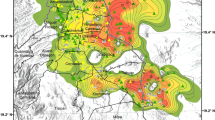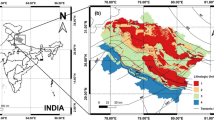Abstract
A landslide is the movement of rock, debris or earth down along the slope under the gravity. It may cause to loss of people’s life and their private and public properties. Landslide is a common hazard in steep slope areas, especially during the rainy season. A study of landslide helps urban planners, engineers and local communities to reduce losses caused by existing and future landslides by means of prevention, mitigation and avoidance. Therefore, the prime aim of this paper is to produce acceptable landslide hazard map for Chenab valley, Jammu and Kashmir. Semiautomatic extraction of the landslide is a suitable method that has been used in this paper to extract the location and extent of the landslides. IRS LISS-IV and CartoDEM have been used for object-based image analysis to extract and prepare a landslide inventory map. About 84 landslide potential sites have been identified by the semiautomatic extraction approach. Landslide numerical risk factor model is derived by using thirteen thematic layers with landslide inventory to prepare the landslide hazard map. The result showed that 21% area of the Chenab valley is falling under the very high hazard zone category of the landslide. The final result of the investigation will definitely be useful in the decision-making procedure at the time of emergency and will be used to prepare a preparedness plan for high-risk areas of Chenab valley. The ROC curve method is used for accuracy assessment that signifies the acceptable result for landslide susceptibility zonation of Chenab valley with 0.956 AUC value.






















Similar content being viewed by others
References
Alzir, F. B., Antunes, C. L., Silva, J. C. D. (2003). Object oriented analysis and semantic network for high resolution image classification. Anais XI SBSR, Belo Horizonte, Brasil, INPE (pp. 273–279)
Barlow, J., Franklin, S., & Martine, Y. (2006). High spatial resolution satellite imagery, DEM derivatives, and image segmentation for the detection of mass wasting processes. Photogrammetric Engineering and Remote Sensing,72, 687–692.
Blaschke, T., Feizizadeh, B., & Hölbling, D. (2014a). Object-based image analysis and digital terrain analysis for locating landslides in the Urmia Lake Basin, Iran. IEEE J Sel Top Appl,7, 4806–4817. https://doi.org/10.1109/JSTARS.2014.2350036.
Blaschke, T., Hay, G. J., Kelly, M., Lang, S., Hofmann, P., Addink, E., et al. (2014b). Geographic object-based image analysis—Towards a new paradigm. ISPRS J Photogramm,87, 180–191.
Borghuis, A., Chang, K., & Lee, H. (2007). Comparison between automated and manual mapping of typhoon-triggered landslides from SPOT-5 imagery. International Journal of Remote Sensing,28, 1843–1856.
Chen, G., Hay, G. J., Carvalho, L. M. T., & Wulder, M. A. (2012). Object-based change detection. International Journal of Remote Sensing, 33(14), 4434–4457. https://doi.org/10.1080/01431161.2011.648285.
Cozier, M. (1986). Landslides-causes, consequences and environment (pp. 0.7097–0.7099). London: Croom Helm Ltd.
Gupta, R. P., & Joshi, B. C. (1990). Landslide hazard zoning using the GIS-approach, a case study from the Ramanga Catchment Himalayas. Engineering Geology,28, 119–131.
Holbling, D., Fureder, P., Antolini, F., Cigna, F., Casagli, N., & Lang, S. (2012). A semi-automated object-based approach for landslide detection validated by persistent scatterer interferometry measures and landslide inventories. Remote Sens,4, 1310–1336. https://doi.org/10.3390/rs4051310.
Hussain, M., Chen, D., Cheng, A., We, H., & Stanley, D. (2013). Change detection from remotely sensed images: From pixel-based to object-based approaches. ISPRS Journal of Photogrammetry and Remote Sensing, 80(2013), 91–106. https://doi.org/10.1016/j.isprsjprs.2013.03.006.
Kurtz, C., Stumpf, A., Malet, J. P., Gançarski, P., Puissant, A., & Passat, N. (2014). Hierarchical extraction of landslides from multiresolution remotely sensed optical images. ISPRS J Photogramm,87, 122–136. https://doi.org/10.1016/j.isprsjprs.2013.11.003.
Lahousse, T., Chang, K.-T., & Lin, Y. (2011). Landslide mapping with multi-scale object-based image analysis—A case study in the Baichi watershed,Taiwan. Nat Hazards Earth Syst Sci,11, 2715–2726. https://doi.org/10.5194/nhess-11-2715-2011.
Martha, T. R., Kerle, N., Jetten, V., van Westen, C. J., & Kumar, K. V. (2010). Characterising spectral, spatial and morphometric properties of landslides for semi-automatic detection using object-oriented methods. Geomorphology,116, 24–36.
Martha, T. R., Kerle, N., van Western, C. J., Jetten, V., & Vinod Kumar, K. (2011). Segment optimization and data-driven thresholding for knowledge-based landslide detection by object-based image analysis. IEEE Transaction on Geoscience and Remote Sensing,116, 24–36.
Martha, T. R., van Westen, C. J., Kerle, N., Jetten, V., & Kumar, K. V. (2012). Landslide hazard and risk assessment using semi-automatically created landslide inventories. Geomorphology Val.,184, 139–150.
Mondini, A. C., Chang, K.-T., & Yin, H.-Y. (2011). Combining multiple change detection indices for mapping landslides triggered by typhoons. Geomorphology,134, 440–451.
Stumpf, A., & Kerle, N. (2011). Object-oriented mapping of landslides using random forests. Remote Sensing of Environment,115, 2564–2577. https://doi.org/10.1016/j.rse.2011.05.013.
Torkashvand, A. M., Irani, A., & Sorur, J. (2014). Preparation of landslide map by landslide numerical risk factor (LNRF) model and geographical information system (GIS). The Egyptian Journal of Remote sensing and Space Science,17, 159–170.
Acknowledgements
The authors would like to thank the General Manager, Regional Remote Sensing-West, Jodhpur, Rajasthan, for their aid and the use of equipment and facilities. The authors would like to give special thanks to two anonymous reviewers for their constructive and useful comments during the review process. Finally, the authors would like to acknowledge all of the agencies and individuals, especially the Survey of India (SOI), Geological Survey of India (GSI) and USGS for obtaining the maps and data required for the study.
Funding
No funding was received for this work.
Author information
Authors and Affiliations
Corresponding author
Additional information
Publisher's Note
Springer Nature remains neutral with regard to jurisdictional claims in published maps and institutional affiliations.
About this article
Cite this article
Patil, A.S., Bhadra, B.K., Panhalkar, S.S. et al. Landslide Susceptibility Mapping Using Landslide Numerical Risk Factor Model and Landslide Inventory Prepared Through OBIA in Chenab Valley, Jammu and Kashmir (India). J Indian Soc Remote Sens 48, 431–449 (2020). https://doi.org/10.1007/s12524-019-01092-5
Received:
Accepted:
Published:
Issue Date:
DOI: https://doi.org/10.1007/s12524-019-01092-5




